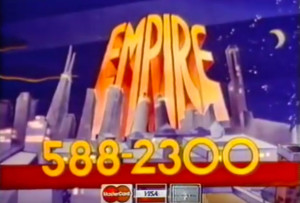 If you’ve ever lived in the Chicagoland area, like I have, chances are that you know this telephone number by heart: 588-2300. What’s so special about that number? It’s the number of Empire Carpet (now Empire Today), which has been etched permanently into my memory by their jingle-filled commercials.
If you’ve ever lived in the Chicagoland area, like I have, chances are that you know this telephone number by heart: 588-2300. What’s so special about that number? It’s the number of Empire Carpet (now Empire Today), which has been etched permanently into my memory by their jingle-filled commercials.
In time, I may forget many of my experiences as an entrepreneur and business coach. I might forget the names of people I’ve worked with, or even the finer details of big events in my life. But as long as I live, I’ll never forget those seven digits.
On the surface, this doesn’t seem like Empire’s approach would be particularly effective. It’s a textbook example of a direct-response campaign, virtually identical to countless other TV and radio ads. And yet, if you start singing the first few bars of the Empire jingle (“Five, eight, eight …”) there is a good chance they will finish it off for you (“… two, three hundred … Em-Piiiire”).
The Empire campaign was effective because it made the next action crystal clear. If you needed some carpet, they wanted you to pick up the phone and call them. You didn’t even need to look up the number, because you already knew it by heart.
It was also a fantastic way to build brand awareness. Everyone in Chicagoland knew about Empire Carpet. Homeowners and landlords knew about Empire. Renters knew about Empire. People with hardwood floors knew about Empire. People who didn’t even speak English, but who had access to a TV or a radio, still knew the Empire Carpet jingle by heart.
That’s powerful advertising. Any time someone in the Chicagoland area needed new carpeting, Empire was the first name that sprang to mind. This wasn’t just true for them, it was true of anyone they asked. Everyone knew that earworm of a jingle, and as a result, everyone knew Empire’s number.
Branding is an important part of any long-term advertising strategy. It isn’t just about bringing in new customers today, it’s about having an instant connection with anyone who is in need of your products or services. Taken to the extreme, it can almost decouple from the product or service you sell.
Coca-Cola is a great example of this. It’s easily one of the most recognized brands in the world. That wasn’t an accident. Billions of dollars have been spent building up the Coca-Cola brand, associating it with the very concept of fun and refreshment. And yet, almost all of Coke’s marketing is completely indirect.
What’s the call-to-action in a Coca-Cola ad? It’s not “Call 555-Coke and order a Coca-Cola!” Most Coke ads aren’t trying to get you to do anything other than remember that Coca-Cola is an impossibly satisfying drink. Which, of course, it isn’t.
Countless blind taste tests have demonstrated that most people, even die-hard soda lovers, struggle to tell the difference between Coke and Pepsi. All of that marketing exists just to nudge potential customers towards the Coca-Cola brand, because the brand is as much the product as the actual drink.
This kind of advertising can be incredibly effective, particularly when there isn’t a substantial difference between a brand and its competition. Geico is another great example. Their ads are pure entertainment, focusing on things like the surreal adventures of talking geckos and pigs, with the actual product of insurance being only referenced indirectly. Geico is banking on the idea that their brand recognition is at least as important as their rates, and that people who need insurance will tend to go with the company they think of first.
As you build your advertising strategy, it’s important to know what results you want. As a direct marketing-focused company, all of Empire Carpet’s advertising is geared towards getting a certain percentage of people to take that all-important action of calling 588-2300. A big part of why they focused on this approach is because they only have one primary channel to bring in new customers. Unlike Coca-Cola, you can’t buy an Empire Carpet installation at your nearest gas station or grocery store.
Products being sold through stores or distributors, on the other hand, don’t really have an incentive to push those same calls-to-action. It doesn’t matter where you buy the Coke, just that you buy it rather than a Pepsi or an RC. In that case, it makes sense to push the brand awareness.
Your product or service might not be an easy fit for either approach, and as a result you may need to test various approaches to find the best response. This is a great opportunity to explore the A/B testing concept I explained previously. As you test and refine your advertising, it won’t be long until you find the system that yields the best results.
